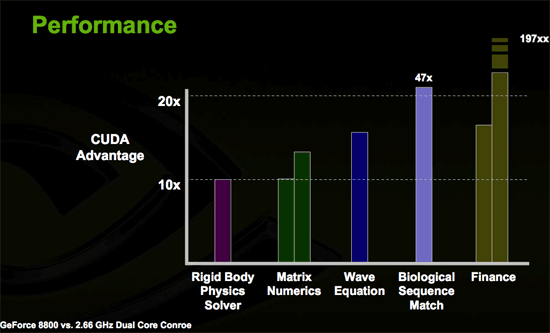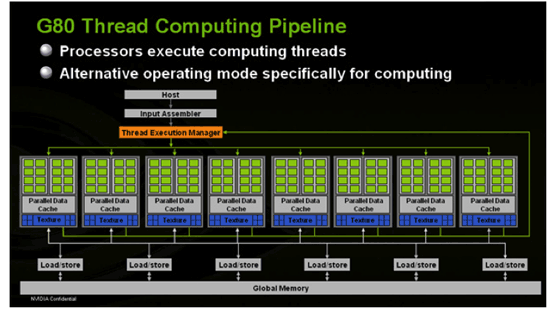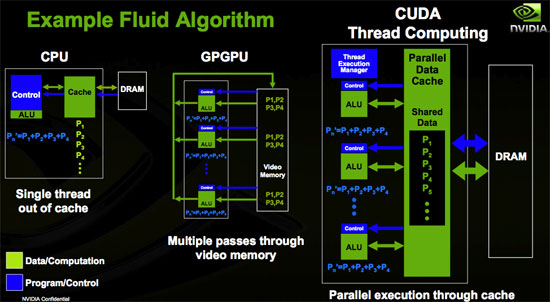NVIDIA's GeForce 8800 (G80): GPUs Re-architected for DirectX 10
by Anand Lal Shimpi & Derek Wilson on November 8, 2006 6:01 PM EST- Posted in
- GPUs
General Purpose Processing
With all the talk about how general purpose G80 is, can we expect it to replace our shiny new quad core desktop processor? This isn't quite possible at this point due to the way most general purpose code uses the CPU. Many dependencies and low parallelism prevent NVIDIA from simply dropping this in a motherboard and running Windows on it.
But there are general purpose tasks that lend themselves well to the parallelism of G80, and NVIDIA is enabling developers to take advantage of this via a technology they call CUDA (Compute Unified Device Architecture).
The major thing to take away from this is that NVIDIA will have a C compiler that is able to generate code targeted at their architecture. We aren't talking about some OpenGL code manipulated to use graphics hardware for math. This will be C code written like a developer would write C.
A programmer will be able to treat G80 like a hugely parallel data processing engine. Applications that require massively parallel compute power will see huge speed up when running on G80 as compared to the CPU. This includes financial analysis, matrix manipulation, physics processing, and all manner of scientific computations.

NVIDIA has written a totally separate driver for G80 that will be used to run compiled C code targeted at G80. The reason they've done this is because the usage model for GPGPU programming is so different from that of graphics. Both the graphics driver and the CUDA driver can be running on G80 at the same time. This may allow programmers to take advantage of CUDA for in game physics on a single card. The driver changes the conceptual layout of the GPU into something that looks more like this:

This design, along with stream output capabilities, allows programmers to treat the GPU like a general purpose data processing engine. Each block of 16 SPs is able to share data with each other and can perform multiple passes on the data without having to write out and read back in from the onboard graphics memory. Developers are given the ability to manage the caches themselves.

Will NVIDIA make an x86 CPU? Most likely not, but we may see NVIDIA produce even more general purpose CPUs for the handheld, CE, integrated markets. NVIDIA may end up becoming a producer of system on a chip solutions utilizing its graphics technology and simply expanding G80 to be more general purpose (and obviously get rid of some of the SPs in order to lower costs).










111 Comments
View All Comments
Nightmare225 - Sunday, November 26, 2006 - link
Are the FPS posted in this article, Minimum FPS, Average FPS, or Maximum? Thanks!multiblitz - Monday, November 20, 2006 - link
I enjoyed your reviews always a lot as they inclueded the video-capbilities for a HTPC on previous cards. Unfortunately this was this time not the case. Hopefully there will be a 2. Part covering this as well ? If so, it would be nice to make a compariosn on picture quality as well against the filters of ffdshow, as nvidia is now as well supporting postprocessing filters...DerekWilson - Tuesday, November 21, 2006 - link
What we know right now is that 8800 gets a 128 out of 130 on HQV tests.We haven't quite put together an HTPC look at 8800, but this is a possibility for the future.
epsil0n - Sunday, November 19, 2006 - link
I am not agree with this:"It isn't surprising to see that NVIDIA's implementation of a unified shader is based on taking a pixel shader quad pipeline, and breaking up the vector units into 4 scalar units. Now, rather than 4 pixel quads, we see 16 SPs per "quad" or block of stream processors. Each block of 16 SPs shares 4 texture address units, 8 texture filter units, and an L1 cache."
If i understood well this sentence tells that given 4 pixels the numbers of SPs involved in the computation are 16. Then, this assumes that each component of the pixel shader is computed horizontally over 16 SP (4pixel x 4rgba = 16SP). But, are you sure??
I didn't found others articles over the web that speculate about this. Reading others articles the main idea that i realized is that a shader is computed by one and only one SP. Each vector instruction (inside the shader) is "mapped" as a sequence of scalar operations (a dot product beetwen two vectors is mapped as 4 MUD/ADD operations). As a consequence, in this scenario 4 pixels are computed only by 4 SPs.
DerekWilson - Tuesday, November 21, 2006 - link
Honestly, NVIDIA wouldn't give us this level of detail. We certainly pressed them about how vertices and pixels map to SPs, but the answer we got was always something about how dynamic the hardware is able to dynamically schedule the SPs optimally according to what needs to be done.They can get away with being obscure about how they actually process the data because it could happen either way and provide the same effect to the developer and gamer alike.
Scheduling the simultaneous processing one vec4 MAD operation on 4 quads (16 pixels) over 4 groups of 4 SPs will take 4 clock cycles (in terms of throughput). Processing the same 16 pixels on 16 SPs will also take 4 clock cycles.
But there are reasons to believe that things happen the way we described. Loading components of 16 different "threads" (verts, pixels or whatever) would likely be harder on the cache than loading all 4 components of 4 different threads. We could see them schedule multiple ops from 4 threads to fill up each block of shaders -- like computing 4 consecutive scalar operations for 4 threads on 16 SPs.
At the same time, it might be easier to maximize SP utilization if 16 threads were processed on one block of SPs every clock.
I think the answer to this question is that NVIDIA knows, they didn't tell us, and all we can do is give it our best guess.
xtknight - Thursday, November 16, 2006 - link
This has been AT's best article in awhile. Tons of great, concise info.I have a question about the gamma corrected AA. This would be detrimental if you've already calibrated your display, correct (assuming the game heeds to the calibration)? Do you know what gamma correction factor the cards use for 'gamma corrected AA'?
DerekWilson - Monday, November 20, 2006 - link
I don't know if they dynamically adjust gamma correction based on monitor (that would be nice though) ...if they don't they likely adjusted for a gamma of either (or between) 2.2 or 2.5.
Also, thanks :-) There was a lot more we wanted to pack in, but I'm glad to see that we did a good job with what we were able to include.
Thanks,
Derek Wilson
bjacobson - Sunday, November 12, 2006 - link
This comment is unrelated, but could you implement some system where after rating a comment, on reload the page goes back to the comment I was just at? Otherwise I rate something halfway down and then have to spend several seconds finding where I just was. Just a little nuissance.Thanks for the great article, fun read.
neo229 - Friday, November 10, 2006 - link
This is a very suspect quote. A card that requires two PCIe power connectors is going to dissipate a lot of heat. More heat means there must be a faster, louder fan or more substantial and costly heat sink. The extra costs associated with providing a truly quiet card mean that the bulk of manufacturers go with the loud fan option.
DerekWilson - Friday, November 10, 2006 - link
If manufacturers go with the NVIDIA reference design, then we will see a nice large heatsink with a huge quiet fan.Really, it does move a lot of air without making a lot of noise ... Are there any devices we can get to measure the airflow of a cooling solution?
We are also seeing some designs using water cooling and theres even one with a thermo-electric (peltier) cooler on it. Manufacturers are going to great lengths to keep this thing running cool without generating much noise.
None of the 8 retail cards we are testing right now generate nearly the noise of the X1950 XTX ... We are working on a retail roundup right now, and we'll absolutely have noise numbers for all of these cards at load.